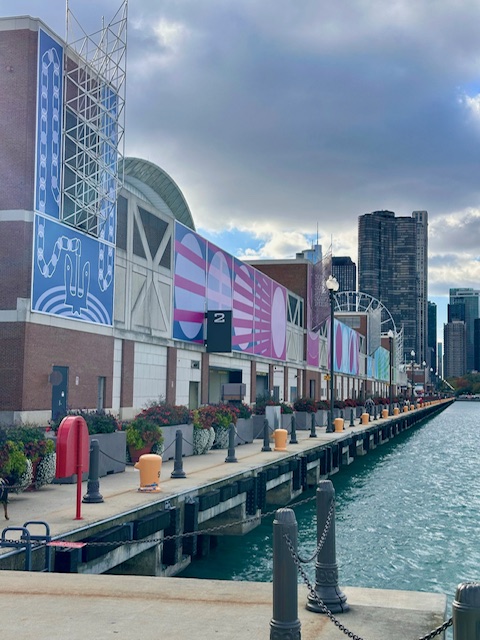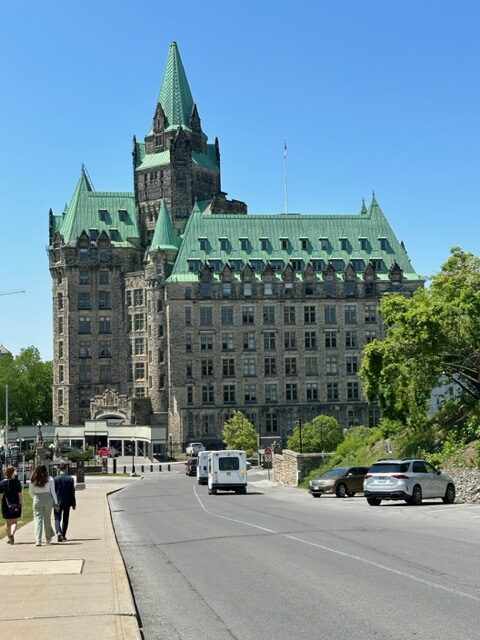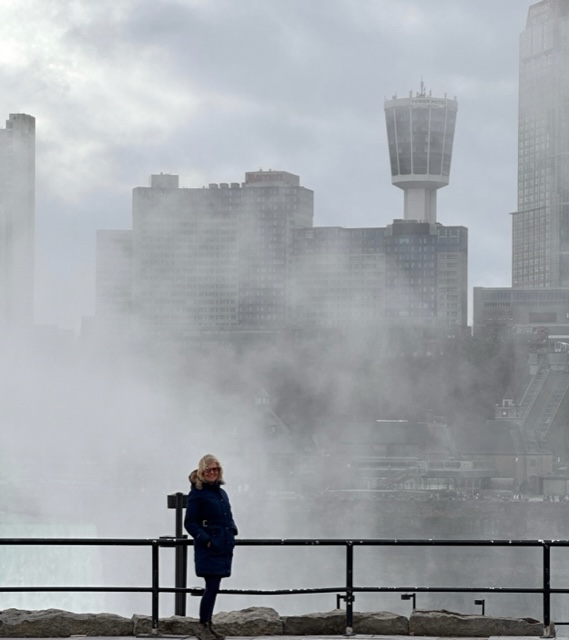St John’s to Gander, Newfoundland – 24 August 2023
Our next stop was Gander. We stopped there for 2 nights and on the second day visited Skipper’s Dog Wash in Lewisporte, NL and met up with owner Steve Woolfrey. What a great guy. Not only did he stock our freezer with Cod he had caught and smoked, he also took us for a ride on his boat. It couldn’t have been a nicer day. It was beautiful and sunny and the water was flat calm. We loved speeding through the water as our competent captain deftly navigated us through the islands while telling us about the history of the area as well as Exploits Island where he has a summer cottage.
He even took us to the site of a shipwreck of the HMS Calypso. This ship, launched in 1883, served as a warship and training vessel for the Newfoundland Royal Naval Reserve. In 1916 it was renamed HMS Briton. After being sold in 1922 it was used in St. John’s for the storage of salt. In 1952 the hulk was moved to Lewisporte harbour. Some thought was given to preservation, but in 1968 it was towed to this coastal bay near Embree, and burned to the waterline. A sad ending to a magnificent ship.
It was brilliant to have a local take us around and we learned so much from him. Thank you so much Steve, it was one of our best days on the Rock!
Back at Gander, we visited Gander’s Aviation museum, and learned about it’s role during the war. Built in 1936, it was a strategic location for refuelling and maintenance and became the main staging point for the movement of Allied aircraft to Europe during World War II. In 1940 it was the largest airport on earth. The airport’s runway 03/21 is designated as an emergency landing runway for NASA’s Space Shuttle orbiter. The airport is also an important emergency landing runway for large aircraft in transatlantic operation in the ETOPS system, which requires aircraft to always have less than a certain distance from a suitable landing site. Gander has two active runways: runway 13/31 which is 8,900 ft × 150 ft and runway 03/21 which measures 10,200 ft × 150 ft.
Another interesting event we learned about was Operation Yellow Ribbon which Gander and several other airports in Canada took part in on Sept 11, 2001. Canada’s goal was to remove potentially destructive air traffic from the US airspace and other potential US targets, and place these aircraft on the ground in Canada, at military and civilian airports. All departing flights (with the exception of police, military, and humanitarian) flights were cancelled. Within 2 hours, the number of flights received at 17 different airports around Canada was between 225 and 250 and the number of passengers was between 30,000 and 45,000. Gander’s own airport took in 38 jumbo jets, parking them wingtip to wingtip on its runway. The number of passengers and crew needing accommodation was about 6,600. The population of Gander at the time was fewer than 10,000 people. It was stated that there were more people at the airport than in the town. Over the next several days, the people of Gander and in surrounding communities responded with countless acts of kindness and generosity, providing food, clothes, beds, showers and places to stay and, perhaps most important, emotional comfort, until US airspace reopened and they could finally return home. Passengers reported that the people of Gander “… were so friendly and open. They just welcomed us … and they were going to take care of us.”
Today a monument featuring a piece of World Trade Center steel that was donated to the Town of Gander by New York firefighters in 2011 stands as an enduring memory outside the Town Hall.
After reading about an aircraft tragedy, we decided to take a drive to see the Silent Witness Memorial site. This park is dedicated to the 256 individuals who lost their lives in the Arrow Air Crash. It still is the deadliest aviation accident to occur on Canadian soil. Arrow Air Flight 1285R was an international charter flight carrying U.S. Army troops from Egypt to Kentucky via West Germany and Gander. All but 12 of the victims were from the 101st Airborne Division flying back to their base in Fort Campbell. They had just completed a six month deployment in the Sinai as part of a peacekeeping mission.
In the early hours of the morning on December 12, 1985, the flight took off and then suddenly stalled, crashed, and burned about half a mile from the runway, killing all 248 passengers and 8 crew members on board.
The memorial at the crash site overlooks Gander Lake, and another memorial was erected at Fort Campbell. There is also a Memorial Park in Hopkinsville, Kentucky, just north of Fort Campbell. As of 2018, the scar from the crash is still visible from the ground and by satellite. The accident was investigated by the Canadian Aviation Safety Board but still today no definitive cause of the disaster has been established. While the Islamic Jihad Organization claimed responsibility for the crash, these claims were dismissed by both the American and Canadian governments.







